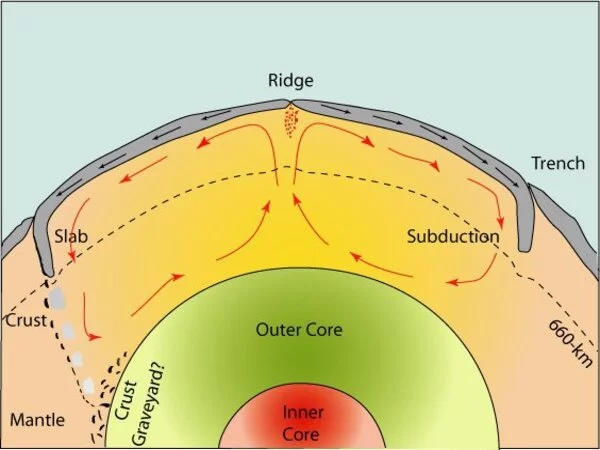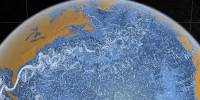The origins of life on Earth are a complex and fascinating topic that scientists are still researching and attempting to comprehend. While plate tectonics has shaped the Earth’s surface and influenced its environment, it is not a strict requirement for the emergence of life.
The new discovery challenges previous assumptions about the role of mobile plate tectonics in the evolution of life on Earth. Furthermore, the data suggests that ‘when we’re looking for exoplanets that might harbour life, the planets don’t necessarily need to have plate tectonics,’ according to the lead author of a new paper.
Scientists have traveled back in time to solve the mysteries of Earth’s early history, studying plate tectonics billions of years ago with tiny mineral crystals called zircons. The study sheds light on early Earth’s conditions, revealing a complex interplay between the Earth’s crust, core, and the emergence of life.
Plate tectonics allows heat from the Earth’s interior to escape to the surface, resulting in the formation of continents and other geological features required for the emergence of life. As a result, “there has been the assumption that plate tectonics is necessary for life,” says John Tarduno, an Earth and Environmental Sciences professor at the University of Rochester. However, new research calls that assumption into question.
We found there wasn’t plate tectonics when life is first thought to originate, and that there wasn’t plate tectonics for hundreds of millions of years after. Our data suggests that when we’re looking for exoplanets that harbor life, the planets do not necessarily need to have plate tectonics.
John Tarduno
Tarduno, the William R. Kenan, Jr. Professor of Geophysics, is the lead author of a Nature paper that examines plate tectonics from 3.9 billion years ago when scientists believe the first signs of life appeared on Earth. The researchers discovered that mobile plate tectonics were not occurring at the time. Instead, they discovered that Earth was releasing heat via a process known as the stagnant lid regime. The findings show that, while plate tectonics is important for sustaining life on Earth, it is not required for life to originate on a terrestrial-like planet.
“We found there wasn’t plate tectonics when life is first thought to originate, and that there wasn’t plate tectonics for hundreds of millions of years after,” says Tarduno. “Our data suggests that when we’re looking for exoplanets that harbor life, the planets do not necessarily need to have plate tectonics.”

An unexpected detour from a study of zircons
The researchers did not originally set out to study plate tectonics. “We were studying the magnetization of zircons because we were studying Earth’s magnetic field,” Tarduno says.
Zircons are tiny crystals that contain magnetic particles that can lock in Earth’s magnetism at the time the zircons were formed. Researchers can create a timeline tracing the evolution of the Earth’s magnetic field by dating the zircons.
The strength and direction of the Earth’s magnetic field vary with latitude. The current magnetic field, for example, is strongest at the poles and weakest at the equator. Scientists can infer the relative latitudes at which zircons formed using information about their magnetic properties. That is, if the efficiency of the geodynamo (the process that generates the magnetic field) remains constant while the intensity of the field varies over time, the latitude at which the zircons form must also vary.
However, Tarduno and his colleagues discovered the opposite: the zircons they studied from South Africa revealed that the strength of the magnetic field did not change between about 3.9 and 3.4 billion years ago, implying that latitudes did not change as well.
“Because plate tectonic motions include changes in latitudes of various land masses,” Tarduno says, “plate tectonic motions likely weren’t occurring during this time, and there must have been another way Earth was removing heat.” The researchers discovered the same patterns in zircons from Western Australia, supporting their findings.
“We aren’t saying the zircons formed on the same continent, but it looks like they formed at the same unchanging latitude, which strengthens our argument that there wasn’t plate tectonic motion occurring at this time,” Tarduno says.
Stagnant lid tectonics: an alternative to plate tectonics
Earth is a heat engine, and plate tectonics is ultimately the release of heat from Earth. But stagnant lid tectonics – which results in cracks in Earth’s surface – are another means of allowing heat to escape from the interior of the planet to form continents and other geological features.
The horizontal movement and interaction of large plates on the Earth’s surface is referred to as plate tectonics. According to Tarduno and his colleagues, plates from the last 600 million years have moved at least 8,500 kilometers (5280 miles) in latitude. In contrast, stagnant lid tectonics describes how the Earth’s outermost layer behaves like a stagnant lid in the absence of active horizontal plate motion. Instead, the outer layer remains in place while the planet’s interior cools. Large plumes of molten material originating in the Earth’s deep interior can cause cracks in the outer layer. Stagnant lid tectonics is not as effective at releasing heat from the Earth’s mantle as plate tectonics, but it can still result in the formation of continents.
“Early Earth was not a planet where everything was dead on the surface,” Tarduno says. “Things were still happening on Earth’s surface; our research indicates they just weren’t happening through plate tectonics. We had at least enough geochemical cycling provided by the stagnant lid processes to produce conditions suitable for the origin of life.”
Maintaining a habitable planet
While Earth is the only known planet to have plate tectonics, other planets, such as Venus, have stagnant lid tectonics, according to Tarduno.
“Because of what is happening on Venus,” he says, “people have tended to think that stagnant lid tectonics would not build a habitable planet. Venus is not a pleasant place to live: it has a suffocating carbon dioxide atmosphere and sulfuric acid clouds.” This is due to ineffective heat removal from the planet’s surface.”
Without plate tectonics, Earth could have experienced a similar fate. While the researchers speculate that plate tectonics began on Earth soon after 3.4 billion years, the geology community is divided on a specific date.
















